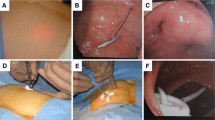Abstract
Purpose
In case reports or small studies, percutaneous endoscopic caecostomy (PEC) has been proposed as an alternative to the Malone intervention to perform antegrade colonic enemas. Our goal was to assess the feasibility, efficacy, and tolerance of PEC in a large group of patients with refractory colorectal functional disorders.
Methods
From September 2006 to April 2014, all patients undergoing PEC for constipation, fecal incontinence, and incontinence after rectal resection in two expert centers were studied. The PEC procedure consisted in anchoring the caecum to the abdominal wall (caecopexy) and placing a specifically designed tube in the colonic lumen to perform antegrade enemas. The quality of life (GIQLI), constipation (Kess), and incontinence (Cleveland) scores were assessed before PEC and at 3, 6, 12, and 24 months.
Results
A total of 69 patients were included. GIQLI scores were significantly improved in constipation group (n = 43), incontinence group (n = 19), and rectal resection group (n = 10). In the constipation group, Kess score decreased from 25.9 before PEC to 20.6 at 2 years (p = 0.01). In the incontinence and post-rectal resection groups, Cleveland scores decreased from 14.3 before PEC to 2.7 at 6 months (p = 0.01) and to 10.4 at 2 years (p = 0.04). Overall, PEC was considered successful by patients in 58%, 74%, and 90% of cases, in constipation, incontinence, and rectal resection groups, respectively. Chronic pain (52%) at the catheter site was the most frequent complication.
Conclusions
Percutaneous endoscopic caecostomy for antegrade colonic enemas improves significantly the quality of life of patients with colorectal disorder refractory to medical treatment.






Similar content being viewed by others
References
Mason HJ, Serrano-Ikkos E, Kamm MA (2000) Psychological morbidity in women with idiopathic constipation. Am J Gastroenterol 95(10):2852–2857
Belsey J, Greenfield S, Candy D, Geraint M (2010) Systematic review: impact of constipation on quality of life in adults and children. Aliment Pharmacol Ther 31(9):938–949
Dudekula A, Huftless S, Bielefeldt K (2015) Colectomy for constipation: time trends and impact based on the US Nationwide inpatient sample, 1998-2011. Aliment Pharmacol Ther 42(11–12):1281–1293
Malone PS, Ransley PG, Kiely EM (1990) Preliminary report: the antegrade continence enema. Lancet Lond Engl 336(8725):1217–1218
Gerharz EW, Vik V, Webb G, Leaver R, Shah PJ, Woodhouse CR (1997) The value of the MACE (Malone antegrade colonic enema) procedure in adult patients. J Am Coll Surg 185(6):544–547
Kiely EM, Ade-Ajayi N, Wheeler RA (1994) Caecal flap conduit for antegrade continence enemas. Br J Surg 81(8):1215
Marsh PJ, Kiff ES (1996) Ileocaecostomy: an alternative surgical procedure for antegrade colonic enema. Br J Surg 83(4):507–508
Christensen P, Buntzen S, Krogh K, Laurberg S (2001) Ileal neoappendicostomy for antegrade colonic irrigation. Br J Surg 88(12):1637–1638
Lees NP, Hodson P, Hill J, Pearson RC, MacLennan I (2004) Long-term results of the antegrade continent enema procedure for constipation in adults. Color Dis Off J Assoc Coloproctology G B Irel 6(5):362–368
Heshmat S, DeFoor W, Minevich E, Reddy P, Reeves D, Sheldon C (2008) Use of customized MIC-KEY gastrostomy button for management of MACE stomal complications. Urology 72(5):1026–1029
Meurette G, Lehur P-A, Coron E, Regenet N (2010) Long-term results of Malone’s procedure with antegrade irrigation for severe chronic constipation. Gastroentérologie Clin Biol 34(3):209–212
Uno Y (2006) Introducer method of percutaneous endoscopic cecostomy and antegrade continence enema by use of the Chait trapdoor cecostomy catheter in patients with adult neurogenic bowel. Gastrointest Endosc 63(4):666–673
Duchalais E, Meurette G, Mantoo SK, Le Rhun M, Varannes SB d, Lehur P-A et al (2015) Percutaneous endoscopic caecostomy for severe constipation in adults: feasibility, durability, functional and quality of life results at 1 year follow-up. Surg Endosc 29(3):620–626
Eypasch E, Williams JI, Wood-Dauphinee S, Ure BM, Schmülling C, Neugebauer E et al (1995) Gastrointestinal quality of life index: development, validation and application of a new instrument. Br J Surg 82(2):216–222
Slim K, Bousquet J, Kwiatkowski F, Lescure G, Pezet D, Chipponi J (1999) First validation of the French version of the gastrointestinal quality of life index (GIQLI). Gastroentérologie Clin Biol 23(1):25–31
Knowles CH, Eccersley AJ, Scott SM, Walker SM, Reeves B, Lunniss PJ (2000) Linear discriminant analysis of symptoms in patients with chronic constipation: validation of a new scoring system (KESS). Dis Colon Rectum 43(10):1419–1426
Jorge JM, Wexner SD (1993) Etiology and management of fecal incontinence. Dis Colon Rectum 36(1):77–97
Biyani D, Barrow E, Hodson P, Watson AJM, Maclennan I (2007) Endoscopically placed caecostomy buttons: a trial ACE procedure. Color Dis Off J Assoc Coloproctology G B Irel 9(4):373–376
Klaassen Z, Marshall E, Tubbs RS, Louis RG, Wartmann CT, Loukas M (2011) Anatomy of the ilioinguinal and iliohypogastric nerves with observations of their spinal nerve contributions. Clin Anat N Y N 24(4):454–461
Hoy NY, Metcalfe P, Kiddoo DA (2013) Outcomes following fecal continence procedures in patients with neurogenic bowel dysfunction. J Urol 189(6):2293–2297
Acknowledgements
The authors would like to thank the staff of the Digestive disease institute, especially the stomal therapy nurses Cathy Serage and Guylene Fachet, and the endoscopy staff.
Funding
The authors have not received any funding for this study.
Author information
Authors and Affiliations
Corresponding author
Ethics declarations
Conflict of interest
E Coron has received speaker’s fees from Cook medical and Fujifilm, and is member of the board of Medtronic. J Ricard, L Quénéhervé, C Lefevre, M Le Rhun, E Chabrun, E Duchalais-Dassonneville, G Meurette, Y Touchefeu, S Bruley des Varannes, and F Zerbib have nothing to disclose.
Rights and permissions
About this article
Cite this article
Ricard, J., Quénéhervé, L., Lefevre, C. et al. Anterograde colonic irrigations by percutaneous endoscopic caecostomy in refractory colorectal functional disorders. Int J Colorectal Dis 34, 169–175 (2019). https://doi.org/10.1007/s00384-018-3183-7
Accepted:
Published:
Issue Date:
DOI: https://doi.org/10.1007/s00384-018-3183-7




